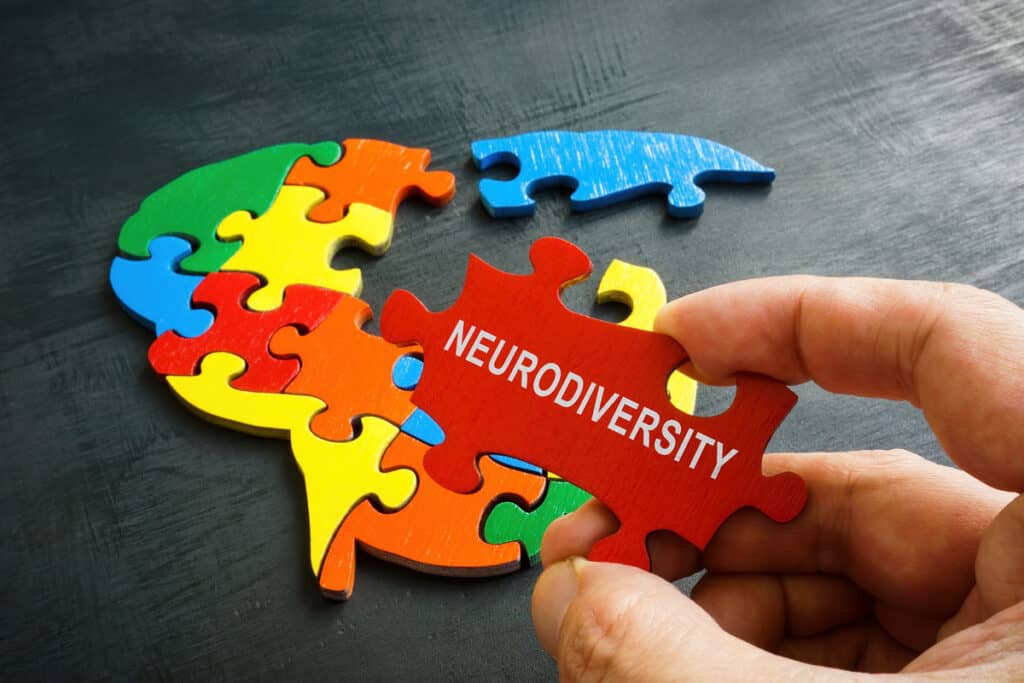Do you feel different to everyone else? Do you feel like no one understands you? Do you feel like you are struggling and you’re not sure why?
Neurodiversity is about appreciating the diversity in the ways people perceive and interact with the world. It’s also about breaking down stigmas, focusing on strengths as opposed to challenges, and celebrating differences as opposed to fixating on disabilities.
Let’s explore your neurodiversity. You have a community to support and guide you. You’re not alone.

Neurodiversity describes the differences in the way people’s brains work. Neurodivergent people experience, interpret, and interact with the world in unique ways, which can sometimes create challenges, but can also lead to creative problem-solving and fresh ideas. The term ‘neurodiversity’ was coined to help fight the stigma against neurodivergent individuals, celebrate differences in thinking, and empower this community to thrive in society. The term ‘neurotypical’ then refers to individuals that experience typical neurological development or functioning.
Although significant progress has been made, there is still a lack of understanding and awareness of neurodiversity in modern society. Society very much caters towards neurotypical individuals, making it more difficult for neurodivergent people to thrive in education, employment, and in their social lives. However, through a greater awareness of these challenges, and by putting certain accommodations and supports in place, neurodivergent people may thrive and excel in society. As well as this, the world can benefit from the strengths and creativity this community has to offer, making our workplaces, education systems, and communities greater places to live. Therapy may be beneficial to neurodivergent people, as it may allow them to explore some of their issues, become aware of their thoughts and feelings, process some of the challenges in their lives, and develop strategies to thrive in the world through a strengths-based, person-centred approach.

Below are some of most common forms of neurodiversity.
Autism
Autism is a neurotype affecting how people perceive, understand, communicate, and experience the world. Autistic people also experience a distinct developmental trajectory. Individually, autistic people are of course very different to each other, but some commonalities may include differences in sensory perception, using sensory information about the environment to understand and learn about the world, a preference for honesty and clarity in communication, a preference for predictability and control, self-expressive body language, a passionate enjoyment of certain interests and hobbies, a strong ability to hyperfocus at times, and sometimes the intense experience of emotions.
ADHD
Attention Deficit Hyperactivity Disorder (ADHD) is a neurotype characterised by differences in brain development and activity that affect attention, impulsivity, and hyperactivity. The lack of transmission of dopamine in neural pathways seems to be linked to ADHD, as dopamine is associated with our motivation to learn and the sense of reward that comes from learning. ADHD also seems to impact an individual’s executive functioning, which relates to organisation and planning. However, there are also several strengths that seem to be associated with ADHD, such as the ability to hyperfocus on a topic of interest, spontaneity, flexibility, creativity, optimism, and a relentless energy.
Dyslexia
Dyslexia is a learning difference that can cause difficulties with learning and work, primarily relating to reading and writing skills. Dyslexic people may also have difficulty processing and remembering information they see and hear, which can affect learning and literacy skills. A person with dyslexia may read and write at a slow pace, confuse the order of letters in a word, be confused by similar looking letters, have poor or inconsistent spelling, find it difficult to carry out a sequence of directions, or struggle with planning and organisation. However, people with dyslexia often have good skills in other areas, such as creative thinking and problem solving.
Dyspraxia
Dyspraxia is a neurodevelopmental difference that affects movement and makes it difficult to perform some coordination skills (e.g., balance, playing sports, or learning to drive a car) and fine motor skills (e.g., writing or using small objects). These difficulties may impact independent living skills and may result in emotional difficulties. However, there are also many strengths associated with dyspraxia, such as big picture thinking, problem solving, creativity, tenacity, and empathy.
Tourette Syndrome
Tourette Syndrome is characterised by involuntary sounds or movements known as tics. Tics are sudden, rapid, recurrent, nonrhythmic motor movements or vocalisations. Tics must be present for a period of 12 months to meet diagnostic criteria. Symptoms typically emerge between the ages of 4 and 6 and tend to reach their peak between the ages of 10 and 12.
For more information on any of the neurotypes mentioned above, please see the resources below.

References & Resources
ADHD Ireland. (2024). What is ADHD/ADD?
Retrieved from: https://adhdireland.ie/general-information/what-is-adhd/
AsIAm: Ireland’s National Autism Charity. (2024). What is Autism?
Retrieved from: https://asiam.ie/advice-guidance/what-is-autism
Dyslexia Association of Ireland. (2024). What is Dyslexia?
Retrieved from: https://dyslexia.ie/info-hub/about-dyslexia/what-is-dyslexia/
Dyspraxia/DCD Ireland. (2024). What is Dyspraxia/DCD?
Retrieved from: https://www.dyspraxia.ie/What-is-Dyspraxia-DCD
Neurodiversity Ireland. (2024). What is Neurodiversity?
Retrieved from: https://neurodiversityireland.com/what-is-neurodiversity/
Psychology Today. (2024). Tourette’s Disorder.
Retrieved from: https://www.psychologytoday.com/ie/conditions/tourettes-disorder